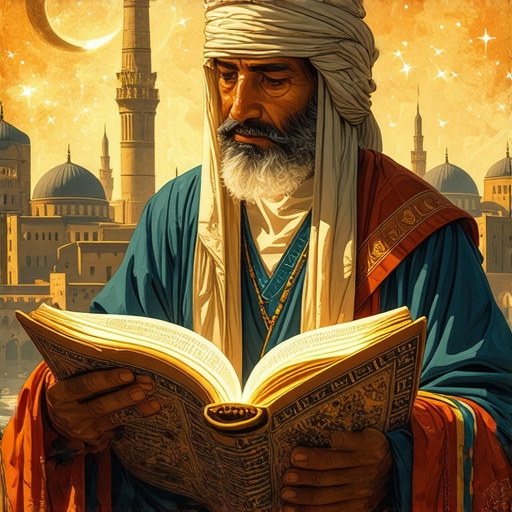My Personal Encounter with Dream Interpretation in Islam
As someone deeply interested in spiritual growth and Islamic teachings, I vividly remember the first time I sought to understand the principles of dream interpretation in Islam. It was during a period of reflection that I experienced a vivid dream, sparking my curiosity about how dreams serve as divine messages. This journey not only deepened my faith but also helped me recognize sacred symbols and messages that often appear in my dreams.
Why Are Dreams Considered Sacred in Islam?
In Islam, dreams are believed to be a form of divine communication, especially when they carry meaningful symbols or messages. The Prophet Muhammad (peace be upon him) emphasized the significance of dreams in guiding believers. I learned that dreams can be classified into three types: true dreams (ru’ya), dreams from shaytan, and innocent dreams. Understanding these categories helped me discern between divine guidance and mere subconscious thoughts.
The Principles That Helped Me Decode Dreams Accurately
One principle I found particularly useful was the importance of purity and intention before sleeping. Ensuring that I perform wudu (ablution) and recite specific supplications created a spiritual environment conducive to receiving divine messages. I also discovered that the interpretation of dreams involves recognizing sacred symbols such as animals, colors, or objects, which often have profound meanings in Islamic dream symbolism. For example, seeing water in a dream can symbolize spiritual purification and divine guidance, as explained in this article.
How Do I Approach Dream Interpretation with Confidence?
My approach is rooted in understanding that dreams are a reflection of inner faith and spiritual state. I rely on authentic sources like the works of Ibn al-Qayyim and scholars who have written extensively about dream symbolism. For instance, interpreting a dream about a snake involved understanding its dual symbolism—danger and divine warnings—covered in this resource. I also seek guidance from knowledgeable scholars and pray for clarity.
What Are the Common Mistakes to Avoid When Interpreting Dreams?
One mistake I made early on was rushing to interpret dreams without understanding their context or seeking divine guidance. It’s crucial to approach dream interpretation with humility and awareness that divine messages require careful reflection. I also avoid overinterpreting symbols without consulting authentic sources, as misinterpretation can lead to confusion or misguidance. For accurate insights, I always cross-reference meanings with trusted Islamic dream dictionaries and consult knowledgeable individuals.
If you’re interested in exploring more about dream symbols and their spiritual meanings, I recommend visiting this comprehensive guide.
Sharing your own dream experiences and interpretations can be a powerful way to deepen understanding and strengthen faith. Feel free to comment below or reach out through our contact page.
Deepening Your Understanding of Islamic Dream Symbols and Their Divine Messages
Dream interpretation in Islam is a sacred art that intertwines spiritual insight with cultural wisdom. As I delved further into this divine practice, I realized how crucial it is to understand the nuanced meanings behind common symbols to truly grasp their messages. For instance, dreaming of a river often symbolizes divine flow and spiritual sustenance, echoing the teachings found in this resource. Recognizing these symbols requires both knowledge and spiritual sensitivity, which can be cultivated through prayer and study.
What Are the Common Symbols and Their Hidden Meanings in Islamic Dreams?
Islamic dream symbolism encompasses a broad spectrum of signs—animals, colors, objects, and even specific scenarios—that carry profound spiritual meanings. For example, seeing a moon in a dream often signifies divine guidance and blessings, as interpreted in this article. Similarly, colors such as green are associated with paradise and righteousness, offering reassurance and hope to the dreamer. Understanding these symbols demands both scholarly knowledge and a sincere intention to seek divine wisdom, which is why consulting authentic sources and scholars is essential.
How Can We Differentiate Sacred Dream Messages from Personal Subconscious Thoughts?
Distinguishing divine messages from personal subconscious reflections is a challenge that many believers face. One effective approach is to analyze the context and emotional impact of the dream. If a dream leaves you with a sense of peace, guidance, or divine reassurance, it may be a true dream (ru’ya). Conversely, dreams filled with fear, confusion, or negativity might stem from shaytan or personal anxieties. To enhance clarity, I often pray for guidance and consult trusted Islamic dream dictionaries, such as those by Ibn al-Qayyim or contemporary scholars, to verify interpretations. This practice aligns with the principles laid out in this comprehensive guide.
In What Ways Do Dreams Reflect Our Inner Faith and Spiritual State?
Dreams are a mirror of one’s inner spiritual condition, often revealing subtle aspects of faith and inner purity. For example, recurring dreams about water or light may indicate ongoing spiritual cleansing and enlightenment. As I explored this connection, I found that maintaining purity through wudu and supplication before sleep enhances the likelihood of receiving meaningful divine messages. Additionally, the dream state can serve as a spiritual test or a reminder to strengthen one’s faith. Recognizing these messages requires a balanced approach—combining Islamic teachings, sincere prayer, and introspection. For deeper insight, I recommend exploring the principles of dream interpretation outlined in this detailed guide.
Are There Practical Steps to Enhance the Accuracy of Dream Interpretation?
Absolutely. As an expert, I emphasize the importance of patience, humility, and continual learning. Keeping a dream journal helps track recurring symbols and themes, revealing patterns that may point to divine guidance. Engaging in regular prayer for clarity and consulting knowledgeable scholars or trustworthy dream dictionaries ensures interpretations remain aligned with Islamic teachings. Moreover, avoiding haste or overconfidence is vital—dreams often carry layered meanings that unfold over time. To refine your understanding, I recommend reading more about the principles of accurate dream interpretation in Islam, available here.
If you’ve experienced meaningful dreams or have questions about dream symbolism, I encourage you to share your insights and seek guidance. Engaging with a community of believers not only enriches your understanding but also deepens your spiritual journey. For personalized support or further reading, visit our contact page.
Beyond the Surface: Personal Reflections on Dream Symbols and Their Sacred Layers
As I continued my journey into the realm of Islamic dream interpretation, I found myself increasingly drawn to the subtle nuances that distinguish divine messages from personal subconscious echoes. One realization that profoundly impacted me was how the context of a dream—such as recent life events or spiritual states—can significantly influence its meaning. For instance, dreaming of water not only symbolizes spiritual purification but can also reflect ongoing inner struggles or progress, depending on the dream’s emotional tone and circumstances. This layered understanding pushes us to approach each dream with humility and a prayerful mindset, seeking divine guidance rather than rushing to conclusions.
How Do Advanced Symbols Reflect the Complexity of Divine Communication?
Over time, I observed that certain symbols—like animals, celestial objects, or specific numbers—carry multiple layers of meaning. For example, a snake may symbolize danger or divine warning but could also represent hidden knowledge or spiritual tests, as explored in this detailed resource. Recognizing these complex symbols requires familiarity with authentic sources and an intuitive sense cultivated through prayer and study. The challenge lies in discerning which layer of meaning applies to each individual dream, emphasizing the importance of ongoing learning and spiritual sensitivity.
Can Artificial Intelligence Deepen Our Understanding of Sacred Dream Symbols?
Interestingly, I’ve pondered whether AI tools, like advanced dream interpreters rooted in Islamic principles, can assist believers in decoding dreams more accurately. While AI can analyze patterns and cross-reference symbols with religious texts, it cannot replace the spiritual intuition cultivated through sincere worship and supplication. The integration of technology should serve as a complementary tool, guiding us to authentic sources and offering perspectives that enhance our understanding. For example, an AI-powered Islamic dream dictionary might highlight subtle connections between symbols, but ultimately, the interpretation remains a deeply personal and spiritual act, guided by Allah and informed by knowledge.
Personal Experiences and Shared Insights: An Invitation to Explore Together
Throughout my personal journey, sharing dreams and interpretations within a community of believers has proven invaluable. The collective wisdom often brings new insights, helping to confirm or refine individual understandings. I encourage you, dear reader, to reflect on your own dreams—perhaps keeping a journal and seeking guidance from trusted scholars. Your experiences can not only deepen your spiritual connection but also contribute to a richer collective knowledge. If you feel inspired, please share your stories or questions in the comments or via our contact page. Together, we can continue unraveling the sacred language of dreams and strengthening our faith.
The Intricacies of Dream Context and Personal Spiritual State
One of the most captivating aspects I’ve encountered is how the same symbol can carry different meanings based on one’s spiritual state or life circumstances. For example, dreaming of a mosque might symbolize spiritual renewal during times of worship or serve as a divine reminder of Allah’s presence in moments of doubt. Conversely, the same dream during a period of spiritual laxity might prompt introspection and renewed devotion. This fluidity underscores the importance of contextual understanding and prayerful reflection, as highlighted in this comprehensive guide.
Deepening Our Connection Through Study and Reflection
To truly grasp the profound messages hidden within dreams, continuous study of classical Islamic texts and contemporary scholarship is essential. Delving into works like those of Ibn al-Qayyim or Al-Nabulsi enriches our understanding of sacred symbols and their layered meanings. Moreover, engaging in regular supplication before sleep—asking Allah for clarity and protection—can open our hearts to divine messages more effectively. I invite you to join me in this ongoing pursuit of spiritual knowledge, exploring more about dream symbolism and interpretation on our website, especially in articles like this detailed guide.
Final Thoughts: Embracing the Sacred Journey of Dream Interpretation
Dream interpretation in Islam is a sacred art that demands both knowledge and spiritual humility. It’s an ongoing journey—one that connects us more deeply to Allah’s guidance and the divine messages woven into our subconscious. As I reflect on my own experiences, I realize that every dream is an opportunity for inner growth, provided we approach it with sincerity and trust in divine wisdom. I encourage you to remain patient and diligent, seeking knowledge and divine assistance. Your dreams could very well be signs from Allah, guiding you along your spiritual path. Feel free to share your insights or questions, and let’s continue this sacred exploration together.
Exploring the Layers of Sacred Dream Symbols in Islamic Mysticism
My journey into the profound symbolism embedded within Islamic dreams has revealed a universe of spiritual intricacies that transcend superficial interpretations. As I delved deeper, I realized that each symbol—be it a celestial body, an animal, or a color—carries multiple layers of divine messages, requiring both scholarly knowledge and spiritual intuition to decode accurately. For instance, dreaming of a celestial sky often signifies divine guidance, but the specific constellation or phase of the moon can hint at particular prophetic times or divine interventions, echoing insights from this detailed resource. Recognizing these multi-faceted symbols demands a nuanced understanding rooted in authentic texts and personal spiritual sensitivity.
How Can We Discern the Contextual Significance of Complex Dream Symbols?
Discerning the layered meanings behind complex symbols involves analyzing the dream’s context within our spiritual state and life circumstances. For example, a snake appearing in a dream may symbolize divine warning or spiritual tests, but its interpretation varies significantly depending on the emotional tone, recent life events, and the dreamer’s inner purity. To deepen this understanding, I often reflect on the teachings of classical scholars like Ibn al-Qayyim, who emphasized the importance of context and sincerity in dream interpretation. Furthermore, consulting authentic Islamic dream dictionaries—such as the comprehensive guide on interpreting dreams of animals—aids in aligning interpretations with divine wisdom. This layered approach ensures we avoid superficial readings and embrace the divine complexity present in our dreams.
Can Modern Technology, Like AI, Enhance Our Understanding of Sacred Dream Symbols?
Indeed, the advent of sophisticated AI tools offers promising avenues for enriching our comprehension of Islamic dream symbolism. These platforms can analyze patterns across numerous dreams, cross-referencing them with classical texts and contemporary scholarship, thus providing nuanced insights that may elude even seasoned interpreters. However, it’s essential to recognize that AI remains a tool—its outputs should complement, not replace, the spiritual discernment cultivated through prayer, study, and divine guidance. As I explore this intersection, I find that AI can serve as an auxiliary resource, helping us uncover subtle connections and layered meanings, provided we approach it with humility and faith. For a deeper understanding of how technology can support sacred knowledge, I recommend exploring recent developments in Islamic dream interpretation tools.
The Sacred Dialogue Between Muhammad’s Teachings and Personal Dream Experiences
Integrating the prophetic traditions into our dream interpretations profoundly enhances their spiritual significance. The sayings of Prophet Muhammad (peace be upon him) provide invaluable guidance on recognizing authentic divine messages versus shaytan’s whispers. For instance, the hadith about true dreams (ru’ya) underscores the importance of sincerity and purity in receiving divine guidance. Reflecting on these teachings, I find that aligning my interpretations with prophetic principles—such as seeking refuge from shaytan, praying for clarity, and verifying symbols through authentic sources—ensures my understanding remains rooted in divine truth. Moreover, exploring how Prophet Muhammad himself experienced and interpreted dreams enriches our appreciation for this sacred art, linking personal visions to the prophetic legacy and divine wisdom.
Engaging the Community in Sacred Dream Interpretation: A Path to Collective Wisdom
One of the most enriching aspects of my spiritual journey has been sharing dreams within a community of believers. Collective reflections often reveal overlooked nuances and foster a deeper understanding of divine messages. By engaging in respectful dialogue and consulting knowledgeable scholars, we create a sacred space for mutual learning and spiritual growth. I encourage you, dear reader, to document your dreams meticulously and seek guidance from trusted sources. Participating in community discussions not only enhances your interpretative skills but also strengthens your faith and connection to divine guidance. To facilitate this, I invite you to share your experiences and questions through our contact page, fostering a collective quest for divine insights and sacred understanding.
Things I Wish I Knew Earlier (or You Might Find Surprising)
The Power of Intention Before Sleep
One of the most underestimated aspects of dream interpretation is the impact of our intentions and purity before sleep. I used to dismiss simple routines, but once I started performing wudu and reciting specific supplications, I noticed more clarity in my dreams, aligning with Islamic teachings about spiritual preparedness.
Symbols Are Multi-Layered
Dream symbols like water, animals, or colors often carry multiple meanings. For example, water can symbolize purification or divine guidance, but its interpretation depends on the dream’s context. This layered symbolism requires patience and deep study to understand fully.
The Context Is Crucial
A recurring lesson I learned is that the same symbol can mean different things depending on my current spiritual state or life circumstances. Dream interpretation isn’t static; it’s a dynamic reflection of our inner faith and outer reality.
Humility Over Haste
Early in my journey, I was eager to interpret dreams quickly. I realized that rushing leads to misinterpretation. Authentic understanding involves humility, prayer, and consulting trusted sources, such as classical scholars or Islamic dream dictionaries.
Dreams Are a Reflection, Not a Prediction
While some dreams may carry divine messages, many are reflections of subconscious thoughts. Recognizing this helps me approach dream interpretation with a balanced perspective—respectful but not overly anxious about predicting the future.
Sharing Dreams Enriches Understanding
Discussing dreams within a community of believers often uncovers insights I hadn’t considered. Sharing experiences fosters collective learning and deepens our spiritual connection.
Resources I’ve Come to Trust Over Time
- Islamic Dream Dictionary by Ibn al-Qayyim: This classic resource offers profound insights into dream symbolism rooted in Islamic scholarship. It’s my go-to for authentic interpretations.
- Al-Nabulsi’s Works on Dream Interpretation: His writings blend spiritual wisdom with practical guidance, helping me approach dreams with reverence and clarity.
- Contemporary Islamic Scholars’ Articles: Websites like Islamskisanovnik.net provide updated, well-referenced insights that complement classical texts and keep me informed about modern interpretations.
Parting Thoughts from My Perspective
Dream interpretation in Islam is a sacred journey that intertwines faith, knowledge, and humility. Over time, I’ve learned that each dream is a unique message from Allah, requiring sincere effort and trust in divine wisdom. I urge you to approach dreams with respect and patience, seeking guidance through prayer and study. If this resonated with you, I’d love to hear your thoughts or experiences. Sharing our insights not only enriches our understanding but also strengthens our faith. Feel free to drop a comment or reach out via our contact page, and let’s continue exploring this divine art together.



Reading through this detailed exploration of dream interpretation in Islam really resonated with me. I’ve personally found that approaching dreams with humility and patience is truly vital—especially when trying to understand symbols that can have multiple meanings. For instance, water in dreams has been a recurring theme in my spiritual journey; sometimes it signifies purification, other times an ongoing spiritual struggle. It makes me wonder, how do others in the community navigate the ambiguity of symbols like animals or celestial bodies, where meanings can vary based on context? I’ve also started keeping a dream journal and praying for clarity before sleep, which seems to deepen my understanding over time. I believe that continued study of classical texts combined with sincere supplication can truly shed light on these divine messages, but I’d love to hear others’ insights or methods for strengthening this process.